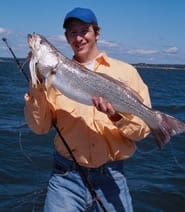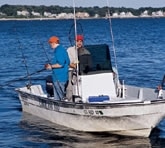
| Recent summers have seen a return of big weakfish – some up to 15 pounds – to the waters of Long Island Sound. |
July can be a slow month for fishing along the southern New England coast. The big run of striped bass is over, bluefish are on hiatus until August, bonito have yet to make their appearance, tautog are moving offshore and fluke are holding deep. Other than messing with porgies, there just isn’t much happening in July. Until now. Suddenly an old favorite – the weakfish – is showing up in Long Island Sound, and now the dog days don’t seem so bleak anymore.
While smaller weakfish prefer shallow waters along beaches, grassy shoals, shellfish flats and channel edges, large weaks – also known as “tiderunners” – favor the deeper rips that form over nearshore reefs and ledges. These fish, which range from eight to 15 pounds, prey on large baitfish such as herring, menhaden, squid, snapper blues and butterfish that hold along the tide-swept structure.
When current flows over a reef or some other type of bottom structure, it forms a line of choppy water called a rip line. It also creates an area of calmer water at the bottom, directly ahead of and behind the reef. It’s in these calm-water zones that tiderunners hold, waiting to ambush baitfish tumbled in the current. And leadhead jigs trolled on wire line are the perfect lures for targeting weaks in these areas.
Rip lines make convenient and precise roadmaps along which to troll. During slower tidal periods it may be possible to troll parallel to the rip; however, when the current is running hard you’ll have to troll into it. “By stemming the tide – that is, using the boat’s power to hold it steady in the current – the lure can be kept in the strike zone,” says Captain Ned Kittredge, a wire-line expert from Dartmouth, Massachusetts, and a Long Island Sound fisherman of over 30 years. “Most days the zone is just ahead of the reef, but other days it’s on top of it or just behind it. Current velocity and the presence of bait, coupled with your experience on each reef, will determine the best location on a given day.”

This fat weak fell for a pink parachute jig fished on wire line. Wire is the best way to reach the biggest fish, which hold deep in the rips.|
Rock Knocking
Keeping your jig at the right depth is also critical. If your jig is just a few feet off the bottom, the weakfish either won’t see it or won’t make the effort to chase it. Most strikes occur when the lure occasionally bumps bottom, but this is when trolling gets tricky.
Reefs, of course, are neither smooth nor of a consistent depth. Anglers who troll their lures at only one depth either fish them above the strike zone or constantly hang bottom. The pros, on the other hand, make rapid adjustments to every depth change by paying out or retrieving wire.
“You want to hit bottom occasionally,” says Kittredge. “That’s how you know your lure is in the strike zone. Plus, the disturbance seems to attract fish. You’ll feel the bumps. When your lure hits a couple of times, immediately take about five fast turns in. If you’re still bumping bottom, take another five. But if you’re trolling along and haven’t felt anything for a while, slowly let line out until the jig makes contact again.”
Slow Down for Fast Action

Another nice weakie is welcomed aboard after falling for the pulsating action of a parachute jig. If you catch one weak, keep working the same spot, as there are sure to be more fish around.|
Proper trolling speed is crucial for catching weakfish, which are neither as fast nor as aggressive as bluefish. In fact, once blues move into an area they usually push the weakfish out. Anglers who troll wire at four to six knots rarely hook up with weaks. That’s because tiderunners, like big stripers, prefer an easy meal that’s swept slowly past their noses. A trolling speed of just 2 1/2 to three knots is optimal for fishing jigs over a reef without having to deploy excessive amounts of wire.
Weakfish pros impart extra action to their jigs by holding the rod tip close to the water and sweeping it back with short, fast strokes. This causes the jig fibers to pulsate like a squid or baitfish. Keep the rhythm as consistent as possible because predators will time a prey’s movement before striking.
In most wire-line situations, it’s common to continue trolling when a hook-up occurs so the other angler can keep fishing and doesn’t hang bottom. This is not a good strategy for weakfish – so named for their delicate mouth tissue – which will easily tear off the hook. You’ll land more fish if you slow to idle speed and have the other angler reel in his line. Sometimes the speed change even prompts a second strike.
Parachute jigs are perfect deep-trolling lures because they can take the abuse of bouncing over a rough bottom, are easy to fish, and are easy remove from a fish’s mouth. Their synthetic skirts are colorful and last longer than natural bucktail, and create a pulsating action that’s irresistible to many species.
| ### New Weakfish RegsLast November, the Atlantic States Marine Fisheries Commission (ASMFC) approved Amendment 4 to the fishery management plan for northern weakfish. At this writing, Connecticut and Rhode Island have a ten-fish daily bag limit, while New York’s is six. All three states have a 16-inch minimum size. Before heading out, check your local regs with the ASMFC at (202) 289-6400 or by visiting www.asmfc.org. |
I have found that a three-ounce jig is the ideal size for fishing the reefs of Long Island Sound. If fishing two outfits, be sure to use the same size jig on both and troll equal amounts of wire to prevent tangles during turns. I like 8/0 hooks for big weaks, which have large mouths. The bigger hooks also hold better than 7/0s if I happen to hook into a slammer blue or big bass.
“I change the factory hooks on my jigs to stainless steel, which won’t rust and discolor the nylon skirt fibers,” says Kittredge. “Once sharpened, stainless steel holds a point longer. Swinging hooks are better than fixed because they give more action and hold better in a weakfish’s soft mouth.

Jigs trolled on wire line should be worked low and slow over the tops of shoals and reefs.|
“The best jig colors seem to be chartreuse or chartreuse-and-white, although pink is productive on some days. For more action, I tip the jig with a five-inch, red-and-white pork strip.”
Three hundred feet of 40-pound wire is more than enough line to troll reefs up to 35 feet deep. For a leader, I start off with 20 feet of 50-pound mono, which gives the lure a more natural appearance and acts as a shock absorber on the strike. Attached to the end of the mono via a snap swivel is four feet of 80-pound fluorocarbon to guard against abrasion. Lastly, I attach the jig to the fluorocarbon with a loop knot.
Wire line needs to be marked for accurate depth reference. The rule of thumb is to let out ten feet of wire for every foot of depth. However, at very slow trolling speeds, 175 to 200 feet of wire fishes well in 25 feet of water, which is the average depth we fish.

Take care not to rip the hook from the fragile mouth of the weakfish.|
Wire can be marked with colored vinyl tape. A common setup is orange tape at the first 100-foot mark, followed by red, white and blue at 50-foot intervals. You can also buy pre-marked wire from Malin, which has proven to be a real time-saver for many fishermen (see “Get Wired!”, SWS, May 2003). Stainless steel is the most popular wire choice because it’s the least expensive, but some anglers prefer Monel and the new Inconel wire.
“My preference is 50-pound Inconel wire (.020″ diameter),” says Kittredge. “This wire has a ‘dead soft’ temper, similar to Monel, but it costs less. It’s less springy, thinner and denser, so it sinks deeper and faster than comparable stainless wire.”
Wire-lining requires a rod that imparts action to the lure yet has a substantial backbone and durable guides. A 6 1/2- to seven-foot rod with a soft tip and stiff butt section rated for 20- to 40-pound line is a good all-around choice. Longer rods allow a greater jigging “sweep” with less effort. The soft tip gives the jig a smooth action while being gentle on the wire so it doesn’t weaken prematurely. Carbide guides, while more expensive, are necessary to prevent grooving caused by contact with the wire.
| ### Local Information * For current regulations, ramp conditions, directions to ramps and a 2003 Connecticut Boater’s Guide, call the DEP’s Connecticut Boating Division at (860) 434-8638. ¿ * For more information on the lcoal fishing and a 2003 Connecticut Angler’s Guide, call the DEP Marine Fisheries office at (860) 434-6043 or visit www.dep.state.ct.us. ¿ * Visitors may contact the Connecticut Tourism Division at (800) CT-BOUND (282-6863); www.ctbound.org. ¿ * To locate reefs and other hot spots in Long Island Sound, contact Capt. Segull’s Nautical Charts at (888) 473-4855; www.captainsegullcharts.com. |
The standard wire-line reel in the Northeast is the Penn 113H 4/0 Senator. However, such a large reel isn’t necessary for weakfish. I have used the lighter, smaller 112H 3/0 Senator with great success. According to Kittredge, similar reels, such as the Shimano TLD 15, work equally well for wire-lining.
Regardless of which rod-and-reel combo you choose, trolling the reefs of Long Island Sound is your ticket to much-needed fishing action during those steamy summer days. As Ned Kittredge says, “If you want a shot at a ‘new’ sport fish this summer, wire-lining for weakfish is the way to go.” Follow his expert advice and you may look forward to those dog days of July.
| ### Rigging for River Reds |

¿Troll parallel to the rip in light current; stem the tide (shown) in a stronger flow.|









